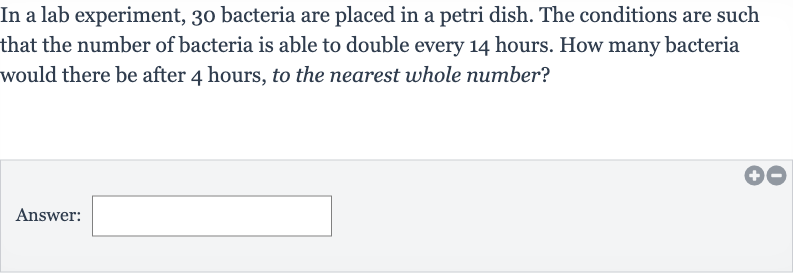AI tutor
Welcome to Bytelearn!
Let’s check out your problem:

In a lab experiment, bacteria are placed in a petri dish. The conditions are such that the number of bacteria is able to double every hours. How many bacteria would there be after hours, to the nearest whole number?Answer:
Full solution
Q. In a lab experiment, bacteria are placed in a petri dish. The conditions are such that the number of bacteria is able to double every hours. How many bacteria would there be after hours, to the nearest whole number?Answer:
- Understand the problem: Understand the problem and determine what is being asked.We need to calculate the number of bacteria after hours, knowing that the initial count is and they double every hours. Since hours is not a full doubling period, we need to find out how much growth occurs in hours as a fraction of the -hour doubling period.
- Calculate fraction of period: Calculate the fraction of the doubling period that has passed after hours. hours is of the -hour period.Fraction of the doubling period =
- Convert fraction to growth factor: Convert the fraction of the doubling period into a growth factor.Since the bacteria double every full period, we need to find the growth factor for the fraction of the period. This can be done using the formula for exponential growth: , where is the final amount, is the initial amount, is the time elapsed, and is the doubling time.Growth factor for hours =
- Calculate growth factor: Calculate the growth factor using the fraction obtained in Step .Growth factor for hours = Using a calculator, we find that
- Apply growth factor: Apply the growth factor to the initial number of bacteria to find the number after hours.Number of bacteria after hours Initial number of bacteria Growth factorNumber of bacteria after hours
- Perform multiplication: Perform the multiplication to find the number of bacteria after hours.Number of bacteria after hours
- Round the result: Round the result to the nearest whole number, as the question asks for an approximation.Number of bacteria after hours, rounded = (to the nearest whole number)
More problems from Convert between customary and metric systems
QuestionGet tutor help
QuestionGet tutor help
QuestionGet tutor help
QuestionGet tutor help
QuestionGet tutor help
QuestionGet tutor help
